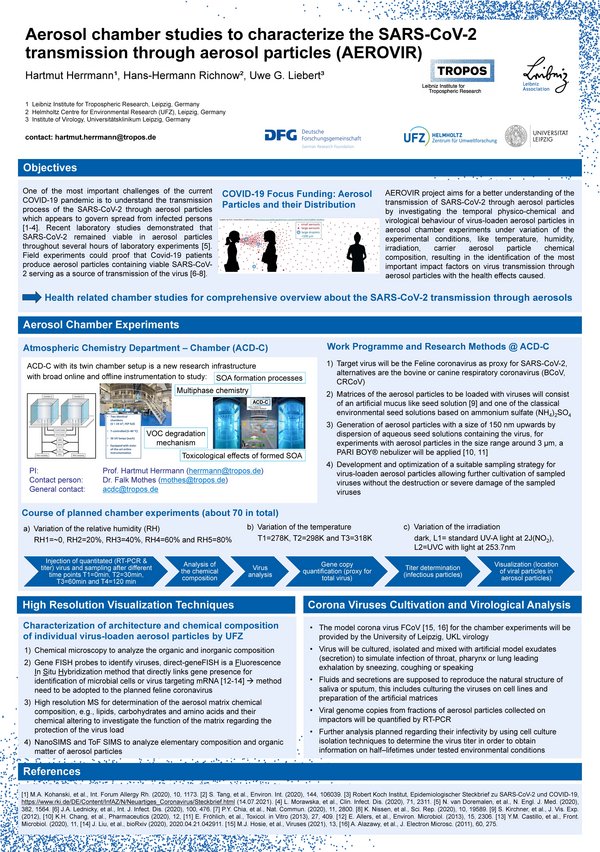Aerosol chamber studies to characterize the SARS-CoV-2 transmission through aerosol particles (AEROVIR)
Project duration: March 2022 to March 2023
Funding: Focus funding "COVID19: Aerosol particles and their dispersion" of the German Research Foundation (DFG)
One of the most important challenges of the current COVID-19 pandemic is to understand the transmission process of the SARS-CoV-2 through aerosol particles which appears to govern spread from infected persons [1-4]. Recent laboratory studies demonstrated that SARS-CoV-2 remained viable in aerosol particles throughout several hours of laboratory experiments [5].
Field experiments could proof that Covid-19 patients produce aerosol particles containing viable SARS-CoV-2 serving as a source of transmission of the virus [6-8].
Therefore, the AEROVIR project aims for a better understanding of the transmission of SARSCoV-2 through aerosol particles by investigating the temporal physico-chemical and virological behaviour of virus-loaden aerosol particles in aerosol chamber experiments under variation of the experimental conditions resulting in the identification of the most important impact factors on virus transmission through aerosol particles with the health effects caused. For the detailed and quantitative elucidation of the parameter dependencies of the virus halflife, experiments are planned in the Atmospheric Chemistry Department – Chamber at the Leibniz Institute for Tropospheric Research, Leipzig investigating the influence of the following parameters: temperature (278 K≤T≤328 K), relative humidity (RH) and aerosol liquid water content (~0≤RH≤0.85), aerosol particle composition (ions, organic matrix, lipids, carbohydrates, peptides) and aerosol particle size (150 nm≤Dp≤3,500 nm). Experiments will be performed in trilateral cooperation with the Department of Isotope Biogeochemistry of the Helmholtz Centre for Environmental Research, Leipzig and the Institute of Virology, Universitätsklinikum Leipzig. The consortium together comprises significant experience in the analysis of differently composed airborne particles under changing environmental conditions, visualization and detection of virus particles and chemical compounds.
The project will deliver a comprehensive data set on lifetimes and infectivity of virus-loaden aerosol particles in dependence of the above-mentioned parameters. The experimentally determined data can be used as input parameters for future modelling of aerosol particle-facilitated spatial spread of the viruses allowing an improved management of the present and also possibly forthcoming future pandemics.
[1] M.A. Kohanski, et al., Int. Forum Allergy Rh. (2020), 10, 1173. [2] S. Tang, et al., Environ. Int. (2020), 144, 106039. [3] Robert Koch Institut, Epidemiologischer Steckbrief zu SARS-CoV-2 und COVID-19 (14.07.2021). [4] L. Morawska, et al., Clin. Infect. Dis. (2020), 71, 2311. [5] N. van Doremalen, et al., N. Engl. J. Med. (2020), 382, 1564. [6] J.A. Lednicky, et al., Int. J. Infect. Dis. (2020), 100, 476. [7] P.Y. Chia, et al., Nat. Commun. (2020), 11, 2800. [8] K. Nissen, et al., Sci. Rep. (2020), 10, 19589.
Links:
DFG COVID-19 Focus Funding: Aerosol Particles and their Distribution
https://www.dfg.de/en/research_funding/corona_information/funding_coronavirus/index.html
&
>
https://gepris.dfg.de/gepris/projekt/468717405?language=en

